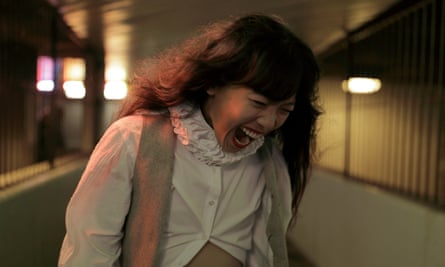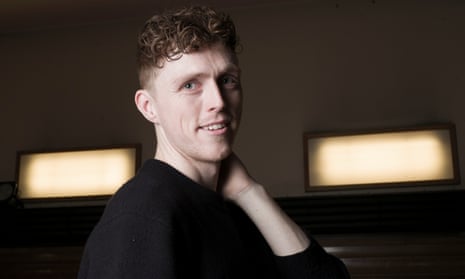“So far, I’ve had a massively fortunate career,” says James Cousins, managing to look both grateful and self-deprecating. The choreographer, now 28, was only one year out of London Contemporary Dance School when he won the first New Adventures Choreographer award and found himself with £15,000 startup money, a year’s mentorship from Matthew Bourne and the chance to showcase his work at Sadler’s Wells. His debut programme, which toured in 2014, revealed choreography crafted into fluent, expressive phrases and driven by highly original ideas. The duet Within Her Eyes was a moving, inventive portrait of loss and dependency in which the female dancer never touched the ground as her partner attempted to cradle her in his arms to contain her untethered emotions.
As his latest piece demonstrates, Cousins also owes his success to risk. Last year, the British Council was preparing a series of Shakespeare-inspired works to be created around the world and it was suggested that Cousins apply for the scheme. As he grimaces, he was initially very reluctant. “I’d never really enjoyed Shakespeare at school, I only had a basic knowledge, and there was just two weeks to get a proposal ready for the deadline.”
Cousins took the gamble and embarked on a lightning study of the plays, focusing on the comedies because his producer told him that he always tended to “do dark things” and should challenge himself. He found himself unexpectedly drawn to As You Like It and to Rosalind, its witty, resourceful heroine.
Cousins was surprised how modern the comedy was, both in its playful handling of gender and in its portrayal of Rosalind, who has to dress like a man to survive in a hostile world. When he looked at the list of countries being offered as creative locations, he thought how interesting it would be to make a version of the play in Seoul. “Gender issues are quite different from here. South Korean men are under pressure to look slim, youthful and smooth-skinned, rather than muscular. And the question of women’s rights is very new and very current. It’s only gained momentum in the last 20 years, and young Koreans are often in tension with their parents about it.”
With his commission approved, Cousins embarked on distilling the play into a contemporary story, with Rosalind and her gender-bending methods of survival at its heart. While he was in Seoul, the run-up to the 2016 US presidential election was entering its final, ugly phase and Cousins couldn’t help but see parallels between Hillary Clinton and his own heroine. “I kept being reminded that 400 years on from Shakespeare, there haven’t been that many changes. Hillary was having to jump through all these hoops. She was having to wear that pant suit, like Rosalind had to dress like man.”
Cousins was also drawn to the moral qualities that Shakespeare had given his heroine – qualities that seemed to him depressingly absent from the US election. “Even though Rosalind has been exiled from court and her father banished, she retains this kindness and positivity. She works to remedy the situation, not just for herself but for everyone else in the play. Last year, when John Kerry [then US secretary of state] was asked to name his Shakespearean icon, he chose Rosalind. He described her as ‘a diplomat, a peacemaker who brings a broken society and a community together’. I got so interested in all these different aspects of her character that I ended up having three dancers playing her.”

It’s a measure of how nuanced Cousins’ portrait became that Rosalind has elicited very different responses from different audiences. In Seoul, it was the work’s feminist politics that stuck the deepest chord: “Audiences got very excited, a lot of people were crying.” When it toured to Indonesia, it was interpreted by the large LGBT community as their own story. Cousins says he will be fascinated to see how the work plays out when it tours the UK this spring.
With only four performers in the cast, it’s a tribute to his storytelling skills that the work has proved so evocative. Yet he says he came late to the idea that dance could be a medium for plot and ideas. When he was a child, it was the speed and spectacle of the long-running Irish dance show Riverdance that first got him hooked. “I loved Jean Butler, the way she flew around the stage.” He used to copy the dance routines of Britney Spears and S Club 7 and teach them to his friends. His first dance classes were part of the PE curriculum at his secondary school and when he began his formal training at LCDS, it was the pure “physicality” of dance that motivated him to choreograph. “I was interested in really fast-paced, full-bodied athletic movement.”
Cousins remembers one of his teachers saying: “If you can incorporate some emotion into what you do, there’ll be no stopping you.” But at that point he wasn’t sure how. Something changed when he was being mentored by Bourne. “I was making a solo and Matt suggested that I played with the focus of the dancer’s eyes, making them move between the light he was standing under, and the corner of the room. Suddenly, I saw there was a story there, just in that change of focus. I realised that I didn’t have to change the kind of steps I was making if I wanted to tell stories, it was all about how I used the dancers’ faces and their eyes.”

Bourne’s mentorship was altogether brilliant, says Cousins. There was no suggestion of his trying to copy the former’s style (although he counts performing the New York run of Bourne’s Swan Lake as one of the highlights of his dancing life). But Bourne was invaluable in passing on practical professional advice about how to develop a career, market a work and seek funding. When Cousins graduated in 2010, arts budgets were being slashed and there were no realistic hopes of an improvement. Cousins says he owes much of his own survival to the canny strategic thinking he acquired from his mentor.
“I was so naive. When I first won that award I was already imagining my name in lights, and filling Sadler’s Wells.” Yet while he secured some early funding, set up his own company in 2014 and won commissions to create works for other companies (including Royal Ballet of Flanders and Scottish Ballet), it proved to be a “real slog” to keep his career moving forward, expand his company and develop his work. “You reach a dead spot when you’re no longer being funded as an emerging talent but not yet an established name.”
The new work he’s developing, based on Patrick Marber’s play Closer, may have a cast of eight – double the size of Rosalind – but to pay his dancers proper wages (an absolute point of principle), Cousins often can’t pay himself. He longs to incorporate serious design elements into the work – “I dream of moving stages and big glass boxes,” he grins – but as yet these are beyond his resources.
He accepts, too, that the dream of filling Sadler’s Wells is a distant one. Yet even though he knows few choreographers can aspire to Bourne’s populist genius, he believes his own work can appeal beyond a niche contemporary dance crowd.
“Some of what I do might seem quite experimental, abstract, but I’ve always liked street dance and jazz. I like to try other styles and think they allow me to speak to a wider audience. It’s important for me to get my work out there, and not to alienate people. My dad was a rugby player and has no real interest in dance, but when I make a work, when my dad comes to see it and enjoys it, then I think … Yes, I’ve done it.”
- Rosalind is at the Place, London, 15-18 March, and is touring until 5 May.

Comments (…)
Sign in or create your Guardian account to join the discussion